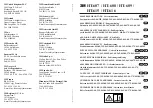
12
Cleaning and Storage
•
Use warm soapy water and clean with sponge or soft brush.
•
To remove scuffs from your paddleboard, use the rough side of a basic sponge (
Do
Not Use Steel Wool
), dip it in warm soapy water then scrub in a circular motion until
all marks are removed (Follow by rinsing).
•
When not being used, we recommend that you store it in a covered, shaded area.
This will help protect it against ultraviolet (UV) rays and extend the life of the
product.
•
Secure the product to prevent unauthorized or unsupervised use.
•
Do not leave board in direct sunlight for long periods of time when not in use.
Repairs
•
To repair cracks or breakage of the board’s fiberglass surface use marine resin
epoxy to patch and fill the damaged area. (Make sure to follow the manufacturer’s
instructions when using and applying any product). Use epoxy resin repair products
only. Do not use polyester resins or other fillers.
•
To repair a deck pad bubble, puncture it with a pin and press the air out of it until flat.
To repair a tear in the deck pad make sure it is dry then dab some super glue under
the damaged area and press it down until secured.
Transportation
When transporting your equipment make sure to use proper tie down straps to secure
your board. (Do Not Use Ratchet Straps) To purchase proper straps and pads visit
www.ravesup.com.
When placing a board on your car flip it upside down with the deck pad and curvature of
the board facing down towards the roof of the car. The tip or the tail of the board may face
forward but it is preferred to have the tail facing forward in most instances.
Watercraft Registration
Check with your local licensing bureau regarding watercraft registration requirements for
your SUP, if any. If you are required to license your paddleboard, you will need to provide
a serial number, which is located at the back of the board, usually adjacent to the fin box.
Note: on some soft top SUPs, the serial number is located at the bottom of the recessed
handle pocket.


































